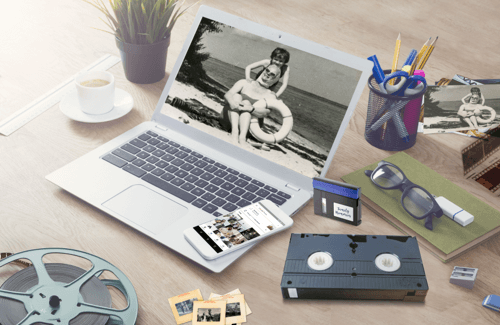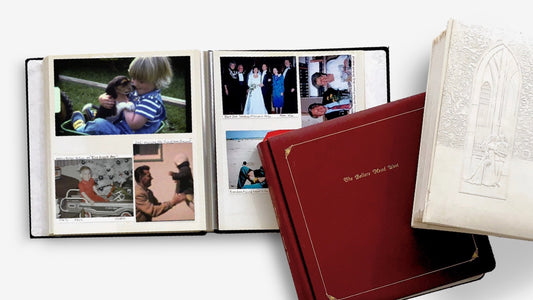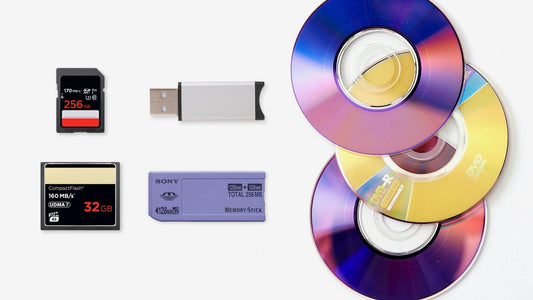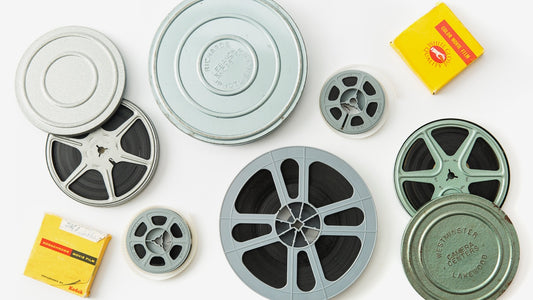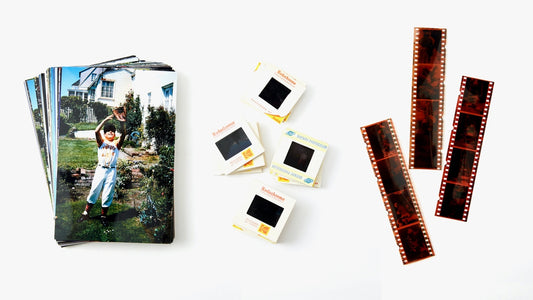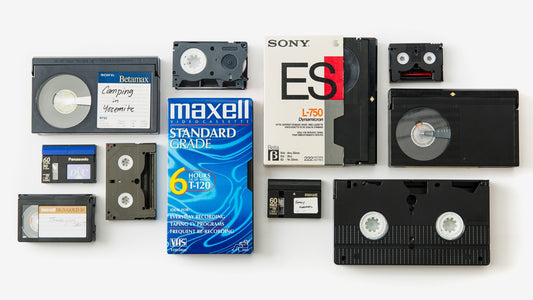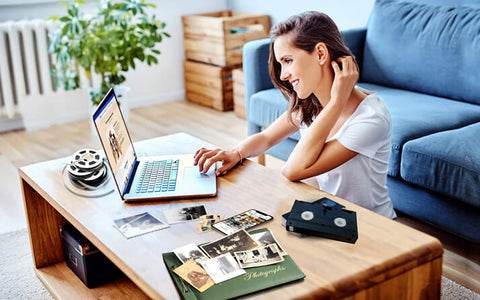Digitizing your family’s memories doesn’t have to be a solo mission. In fact, it’s the perfect opportunity to bring everyone together. Turning this task into a family project transforms it from a chore into a meaningful bonding experience. Your grandparents hold the stories behind the photos, while younger relatives can bring their tech-savvy skills to the table. It’s a chance to share laughter, bridge generational gaps, and create a shared sense of identity. By working together, you not only get the job done faster, but you also create new memories in the process of saving old ones and preserve family history digitally for everyone.
Key Takeaways
- Add Context to Every Memory: A photo is just an image until you add its story. Involve family members to record oral histories and label your digital files with names, dates, and locations to create a rich, meaningful archive for future generations.
- Create a Foolproof Backup System: Protect your digital archive from being lost by following the 3-2-1 rule. Keep at least three copies of your files on two different types of media, with one copy stored securely off-site in the cloud.
- Turn Preservation into a Family Project: You don't have to tackle this alone. Involve multiple generations to share the workload, capture stories more accurately, and transform the task of digitizing into a memorable bonding experience.
Why Digitize Your Family History?
That box of VHS tapes in the attic or the photo albums tucked away in a closet are more than just old media; they're your family’s story. Taking the time to digitize these memories is one of the most meaningful projects you can undertake. It’s about more than just clearing out clutter—it’s about safeguarding your legacy, connecting with loved ones, and ensuring your family’s history can be shared for years to come. By turning analog memories into digital files, you create a permanent, accessible archive that your whole family can enjoy.
Protect Your Memories from Fading
Physical media has a lifespan. Photos fade and discolor, film reels become brittle, and videotapes degrade with every play. The longer you wait, the more you risk losing the quality—and eventually, the entirety—of these precious moments. Digitizing acts as a stop-button on this decay. Creating a high-quality digital copy of a photograph or home movie preserves it exactly as it is today. Think of it as a rescue mission for your memories. Services that specialize in photo transfer can capture crisp, clear digital versions of your prints, slides, and negatives, ensuring they won’t fade any further.
The Perks of Going Digital
Once your memories are digitized, a whole new world of possibilities opens up. You can finally share that hilarious home movie from 1992 with your cousins who live across the country, all with a simple click. Digital files make it easy to create slideshows for anniversaries, build a family history blog, or design custom photo books. It’s also a fantastic way to engage younger family members in their heritage. Showing them a video of their grandparents' wedding or a photo of their mom as a toddler makes family history feel real and immediate, not like a distant story.
Common Roadblocks to Preservation
It’s completely normal to feel a little hesitant about this process. For many, privacy is a major concern. You might worry about personal stories or images being shared too widely. Others are concerned about accuracy, especially when it comes to building online family trees where misinformation can spread easily. The good news is that when you create your own digital archive, you are in complete control. You decide who sees what and when. By handling the digitization yourself or using a trusted service, you can ensure your family’s narrative is preserved accurately and shared securely, only with the people you choose.
Gather Your Tools
Before you dive into scanning boxes of photos and documents, let's talk about getting your toolkit ready. Having the right equipment and software from the start will make the entire process smoother and far more enjoyable. Think of this as your project prep phase—a little planning here goes a long way in creating a digital archive you’ll be proud of. You don't need a professional archivist's lab, but a few key items will ensure your memories are preserved with the quality they deserve.
From choosing a scanner that fits your needs to setting clear quality standards, we’ll walk through everything you need to get organized. This step is all about setting yourself up for success. If you're working with a variety of media, like old home movies and photo albums, you might find that a mix of DIY methods and professional help is the best approach. For delicate or outdated formats like VHS tapes or 8mm film, a dedicated video transfer service can handle the tricky conversion, leaving you to focus on photos and documents.
Choose the Right Scanner
When it comes to scanners, bigger isn't always better. You don't need the most expensive model on the market to get great results. For most family photos and documents, a flatbed scanner with a maximum resolution of 1200 DPI (dots per inch) is more than enough to capture the details you care about. The most important thing is to choose a tool that works for the media you have.
A flatbed scanner is perfect for loose photos, letters, and certificates. If you have a lot of old 35mm slides or film negatives, you might consider a dedicated film scanner to get the best quality. For entire photo albums with pictures you can't remove, using a professional album scanning service can be a lifesaver, as they have the technology to digitize pages without damaging the originals.
Find the Best Conversion Tools
Once you have a scanner, you need software to turn those scans into a searchable, organized archive. This is where the magic really happens. Look for software with Optical Character Recognition (OCR), which is a fancy way of saying it can read the text in your scanned documents. This feature turns an old, handwritten letter into a searchable file, so you can easily find it later by typing in a name or a place.
For long-term preservation, saving documents in a PDF/A format is a great choice. This format is specifically designed for archiving, ensuring your files will be readable for decades to come. While you can manage photo and document conversion at home, converting analog media like film requires specialized equipment. A professional film transfer service handles this complex process, delivering digital files that are ready to watch and share.
Pick Your Software
With your memories digitized, you need a central place to organize them and piece together your family’s story. This is where genealogy software comes in. A dedicated program can help you build an interactive family tree, linking photos, documents, and stories to specific ancestors. Tools like webtrees are designed specifically for this, making it easy to visualize connections and share your findings with relatives.
Think of this software as the digital hub for your family history. Instead of just having folders full of files, you can create a rich, interconnected narrative. You can attach a scanned wedding certificate to a couple's profile, link a photo to the person in it, and add notes from your research. It transforms your collection of files into a living, breathing family history.
Set Your Quality Standards
Before you scan your first photo, decide on the quality you're aiming for. Setting standards from the beginning ensures consistency and saves you from having to rescan everything later. A good rule of thumb is to scan images so that the longest side is at least 3000 pixels. This gives you a high-quality master file that you can easily print or zoom in on without losing clarity.
For specific formats, the recommendations vary. For 35mm slides and negatives, you’ll want to scan at 2200 DPI or higher to capture all the fine details. For a larger 8" x 10" print, 300 DPI is usually sufficient. The goal is to create a digital "original" that's as good as—or even better than—the physical copy. When you use a photo transfer service, the technicians have already perfected these settings to ensure every image is preserved beautifully.
Build a Secure Digital Archive
Once your precious home movies and photos are digitized, you’ve won half the battle. The next step is just as important: creating a secure and organized digital home for them. Think of it as building a digital vault for your family’s legacy. A well-structured archive ensures your memories are not only safe from physical decay but are also easy to find, enjoy, and share for generations to come. It’s about turning a collection of files into a living, breathing family history that everyone can connect with. After completing a photo transfer, you'll have the raw materials to build this archive. Let’s walk through how to create one that’s safe, organized, and built to last.
Organize Your Digital Files
A jumble of digital files is just as overwhelming as a box of loose photos. To make your archive useful, you need a system. Start by creating a main folder for your family history, then create subfolders that make sense to you—perhaps by year, by family branch, or by event (e.g., "1990s," "Johnson Family," "Summer Vacations"). A consistent file naming system is also a game-changer. Instead of "IMG_2056.jpg," try something descriptive like "1995-07-04_FamilyReunion_GrandmaJane.jpg." This simple step will make it infinitely easier to locate specific memories down the road.
Add Context with Metadata
A photo of a smiling group is nice, but knowing who they are, where they were, and what they were celebrating makes it a story. This is where metadata comes in. Metadata is simply information about your files, and you can add it directly to your digital photos. Take a few moments to add names, dates, locations, and a brief description for each image. Most photo applications and even your computer’s operating system have built-in tools for this. This context is invaluable, as it preserves the significance of your family history for relatives who weren't there.
Create a Foolproof Backup Plan
Technology can fail, so relying on a single device to store your entire family history is a risky move. The best practice is to follow the 3-2-1 backup rule: keep at least three copies of your files, on two different types of media, with one copy stored off-site. For example, you could store your archive on your computer's hard drive, a separate external hard drive, and a cloud storage service. This redundancy ensures that whether your computer crashes or a disaster strikes, your precious memories are protected from being lost forever.
Choose Your Cloud Storage
Cloud storage is one of the most effective ways to keep your off-site backup safe and accessible. Services like Google Drive, Dropbox, and iCloud offer secure platforms to store your digital archive. The biggest advantage is that you can access your files from any device with an internet connection, making it easy to share memories with family members across the globe. When you use a service like YesVideo for a film transfer, you can often get your memories delivered directly to a cloud account, simplifying this step even further.
Keep Your Memories Private and Secure
Sharing your family’s story doesn’t mean you have to share it with the entire world. Privacy is a valid concern, and modern storage solutions give you full control over who sees your files. Start by using strong, unique passwords for your accounts. When you’re ready to share, most cloud services allow you to create private folders or albums that can only be accessed by people you invite via email or a secure link. This way, you can keep your memories private and secure while still making them easily available to your loved ones.
Preserve the Stories Behind the Photos
Once your photos, videos, and film reels are digitized, the real magic can begin. A picture might be worth a thousand words, but the stories behind them are priceless. Digitizing your media is the first step; enriching it with context is what transforms a collection of files into a living family history. By capturing the narratives, names, and dates associated with each memory, you give future generations the full picture. It’s about adding the who, what, when, and where to the beautiful images you’ve worked so hard to save. This is how you ensure your family’s legacy is not just seen, but also understood and felt for years to come.
Record Oral Histories
Set aside time to sit down with relatives, especially older ones, and simply listen. Use your phone’s voice recorder or video camera to capture their memories in their own words. Ask about the people in the old photos, the stories behind a family event captured on a home movie, or what life was like during a certain era. These recordings become invaluable audio heirlooms. Engaging in family heritage storytelling serves as a living record of your family’s traditions and cultural history, preserving the voices and personalities that photos alone can't capture.
Document the Who, What, and Where
A photo of a smiling couple is lovely, but knowing it’s your great-grandparents on their honeymoon in 1952 makes it a treasure. As you organize your digital files, take the time to add context. You can change the file names to something descriptive (e.g., "Grandma-Jane-High-School-Graduation-1965.jpg") or use software to add metadata with names, dates, and locations. Writing down these details ensures that future family members won’t have to guess who is in the picture or why it was taken.
Create a Digital Time Capsule
Think of your digital archive as a time capsule for your descendants. Curate your most important files—the best photos from your album scanning project, key video clips, and poignant audio stories—into a single, well-organized collection. You could create folders for different branches of the family or for specific decades. A well-organized digital archive makes it easy for you to find specific memories and ensures that future generations can easily understand your family’s journey. This curated collection tells a cohesive story that will be cherished for years.
Build an Interactive Family Tree
Bring your family history to life by creating an interactive family tree. Many online platforms allow you to build a visual tree and attach your newly digitized photos, video clips, and audio recordings to individual family members. This turns your family tree from a simple chart of names and dates into a rich, multimedia experience. It’s a fantastic way to see how everyone is connected and to share the stories and faces of your ancestors. Platforms like Ancestry make it easy to collaborate with relatives and build a comprehensive family history together.
Make It a Family Project
Digitizing your family’s history doesn’t have to be a solo mission you tackle in a dusty attic. Instead, think of it as a chance to bring everyone together. Turning this into a family project transforms a daunting task into a meaningful bonding experience. It’s an opportunity to bridge generational gaps, share laughter over old memories, and create a shared sense of identity. When everyone has a role, the work gets done faster, and the process becomes a memory in itself.
By involving multiple generations, you ensure the stories behind the photos and videos are captured along with the images. Your grandparents hold the keys to the past, while your kids can bring fresh energy and tech-savvy skills to the table. This collaborative effort not only lightens the load but also deepens everyone’s connection to their roots. You’re not just organizing files; you’re building a living, breathing archive that your family will treasure for years to come.
Get Older Generations Involved
Your parents, grandparents, and other elders are the most valuable resource in this entire process. They are the living storytellers who can breathe life into old photos and silent films. Set aside time to sit with them as you sort through boxes of memories. As you pull out each item, ask them to share what they remember. Who are the people in the photo? What was the occasion? Where was this video taken?
Hosting these informal storytelling sessions is a powerful way to preserve family histories that would otherwise be lost. Consider using your phone to record their stories as they speak. This audio can be saved alongside the digitized photos and videos, adding an incredibly personal layer to your digital archive.
Make It Fun for the Kids
Getting children involved is a fantastic way to teach them about their heritage and make them feel connected to their roots. Frame the project as a treasure hunt or a detective mission. Give them age-appropriate jobs, like sorting photos into piles of "beach trips" or "birthdays." Older kids and teens can take on more technical roles, like operating the scanner or naming digital files according to a system you create together.
This hands-on involvement makes history feel tangible and exciting. You can use the digitized memories to create engaging family history projects, like a slideshow for a family reunion or a custom photo book for a grandparent’s birthday. It’s a wonderful way to show them that family history is more than just names and dates.
Plan a Collaborative Project
To keep things organized and moving forward, treat this like any other group project. Set a regular time to work on it together, like the first Sunday of every month. Assigning roles can also make everyone feel important and keep the process efficient. Maybe one person is the "Chief Curator" in charge of sorting, another is the "Lead Technician" who handles the scanning, and a third is the "Official Scribe" who documents the stories.
By working together, you can teach younger family members about the importance of preserving family history and give them a sense of ownership over their heritage. The goal is to make it a shared effort where everyone’s contribution is valued, turning a big job into a series of manageable and enjoyable tasks.
Overcome Tech Hurdles Together
Let’s be honest—the technical side of digitization can feel intimidating. But you don’t have to be an expert to get it done. Use this as an opportunity for different generations to help each other. A tech-savvy teenager can show a grandparent how to use a new app, while the grandparent can explain the context of a 50-year-old film reel.
If the technology feels like too much of a barrier, remember you don’t have to do it all yourself. Services that specialize in photo transfer can handle the delicate work of converting old formats for you. Outsourcing the technical conversion frees your family up to focus on the most important parts: sorting through memories and sharing the stories that bring them to life.
Share Your Family History
Once you've digitized your family's precious memories, the real magic begins. Sharing these photos, videos, and documents is how you bring your family's story to life, connecting relatives across generations and distances. It’s the step that transforms a personal preservation project into a shared family legacy. But sharing thoughtfully is key to making sure everyone feels included and comfortable. By creating a simple plan for how you’ll share your archive, you can ensure these memories are enjoyed for years to come.
Set Clear Access Levels
It’s completely normal to have some privacy concerns when sharing personal stories and photos. Not every memory is meant for the entire world, and family members might worry about sensitive information being misused. The best way to handle this is by setting clear access levels from the start. Think of it like creating different guest lists for different events. You can organize your digital files into folders for "Immediate Family," "Extended Relatives," or "Close Friends." Many cloud storage and photo-sharing platforms allow you to create private, shareable links for specific folders, giving you complete control over who sees what. This approach respects everyone’s comfort levels and builds trust, making the experience of sharing more joyful for all.
Choose the Right Sharing Platform
With your memories beautifully digitized, you can easily share them with relatives near and far. The right platform makes all the difference. You want something that’s simple for everyone to use, from your tech-savvy cousin to your grandmother. Cloud services like Google Photos or Dropbox are great for creating shared albums. For a more narrative approach, you could create a private family blog or use a genealogy website. When choosing, consider long-term accessibility. A well-organized digital archive ensures that future generations can easily explore your family's history. After you receive your digitized memories from a service like YesVideo, you can upload them directly to your chosen platform and start sharing right away.
Host a Virtual Family Reunion
Why not turn sharing your family history into a special event? Hosting a virtual family reunion is a wonderful way to bring everyone together to relive cherished moments. You can schedule a video call and use a screen-sharing feature to present a slideshow of your newly digitized photos and home movies. To make it more interactive, ask different family members ahead of time to share the story behind a specific photo or video clip. This transforms passive viewing into an active storytelling session, creating new memories while honoring old ones. These kinds of family storytelling events are powerful tools for preserving your family’s unique traditions and strengthening your bond, no matter where everyone lives.
Ensure It Works on Any Device
The goal of sharing your family archive is to include everyone, but technology can sometimes be a barrier, especially for older relatives. Before you send out a single link, make sure your digital collection is accessible on any device—a smartphone, tablet, or desktop computer. Choose a sharing platform that is known for being user-friendly and doesn't require special software or complicated logins. It’s a great idea to test the link yourself on different devices. You could even create a simple, one-page guide with step-by-step instructions for family members who might need a little extra help. A few minutes of preparation ensures that no one is left out of the joy of rediscovering your family’s history.
Keep Your Digital Archive Safe
Once you’ve digitized your family’s precious memories, the next step is to protect them for the long haul. A digital archive isn’t a time capsule you bury and forget; it’s a living collection that needs a little care to ensure it survives for future generations. Think of it like tending to a garden—a bit of regular maintenance keeps everything healthy and accessible. Creating a solid preservation plan now means your great-grandchildren will be able to see that video of your grandpa’s goofy dance moves or read your mom’s handwritten letters. It’s about making sure these digital keepsakes last a lifetime and beyond.
Create a Maintenance Schedule
The best way to protect your digital files is to follow the 3-2-1 backup rule: keep at least three copies of your data, on two different types of media, with one copy stored off-site. A simple way to do this is to save your archive on your computer, on an external hard drive, and in a cloud storage service. This redundancy protects you from everything from a hard drive failure to a house fire. To make sure it all stays up to date, set a recurring reminder in your calendar—maybe once or twice a year—to check on your files. This is your dedicated time to run your backups and make sure every copy is current and complete.
Plan for Future File Formats
Technology changes fast, and a file format that’s common today could be obsolete tomorrow (remember floppy disks?). To keep your archive accessible, it’s smart to save your most important files in formats designed for long-term preservation. For scanned documents and letters, PDF/A is the archival standard. For photos, consider converting your master copies to a Digital Negative (DNG) format. These are open-source formats, meaning they aren’t tied to a single company and are more likely to be readable by future software. When you get a photo transfer, you receive high-quality digital files that you can then convert and save for true long-term security.
Perform Regular Quality Checks
Digital files can degrade over time in a process sometimes called "bit rot," where data gets subtly corrupted. While rare, it’s worth checking for. During your scheduled maintenance, take a few minutes to open a random selection of files from your archive—a few photos, a video clip, a scanned document. Make sure they open correctly and look as they should. This simple spot-check helps you catch any potential issues early. A huge benefit of this process is that you get to enjoy your memories without handling the fragile originals. As the National Archives points out, viewing digital copies prevents the wear and tear that can damage your physical photos and tapes.
Future-Proof Your Family Archive
Where you store your files is just as important as the files themselves. Physical media like USB drives, CDs, and external hard drives are great for short-term backups, but they aren't built to last forever. They can fail, decay, or simply become incompatible with new devices. For true peace of mind, cloud-based storage is the safest bet for your primary off-site backup. Reputable cloud services store your data across multiple secure servers, protecting it from physical damage and hardware failure. After investing in a professional video transfer to save your home movies, storing them in the cloud ensures they remain safe, secure, and ready for the next family movie night, no matter what the future holds.
Related Articles
- How to Create a Digital Family Tree
- A Guide to Archiving Old Photos
- How to Build a Digital Family Archive
- How to Scan Old Printed Photos to Digital
Frequently Asked Questions
This all sounds great, but I'm feeling overwhelmed. What's the best first step? It's completely normal to feel that way! The key is to start small. Instead of thinking about the entire collection, pick just one photo album or a small stack of VHS tapes. Focusing on a single, manageable batch makes the project feel much more achievable. Once you complete that first set, you’ll build momentum and confidence to continue.
I'm worried about damaging my old photos and tapes. What if they're too fragile to handle? That's a very valid concern, as older media can be incredibly delicate. If you have items that are brittle, faded, or in a format you don't recognize, it's often safest to trust them to professionals. Services that specialize in digitization have the proper equipment to handle fragile materials carefully, ensuring your memories are preserved without risking damage.
Should I try to digitize everything myself or use a professional service? There’s no single right answer—it often comes down to your media type, your budget, and how much time you have. A hybrid approach works well for many families. You might handle scanning standard photo prints and letters at home, while leaving the more complex formats like 8mm film reels and videotapes to a dedicated transfer service that has the specialized technology.
What's the single most important tip for organizing my digital files? Create a consistent file naming system from the very beginning. It might seem tedious at first, but naming files with a clear structure, like "YYYY-MM-DD_Event_People," will save you countless hours later. This simple habit turns a chaotic folder of images into a searchable archive where you can find exactly what you're looking for in seconds.
How can I encourage my family to actually engage with our newly digitized history? The best way to get your family interested is to make it an event. Instead of just sending a link to a folder, create a slideshow of the best photos and play it at the next family gathering. You could also host a virtual "movie night" to watch old home movies together on a video call. When you present these memories as a shared experience, it brings them to life for everyone.





